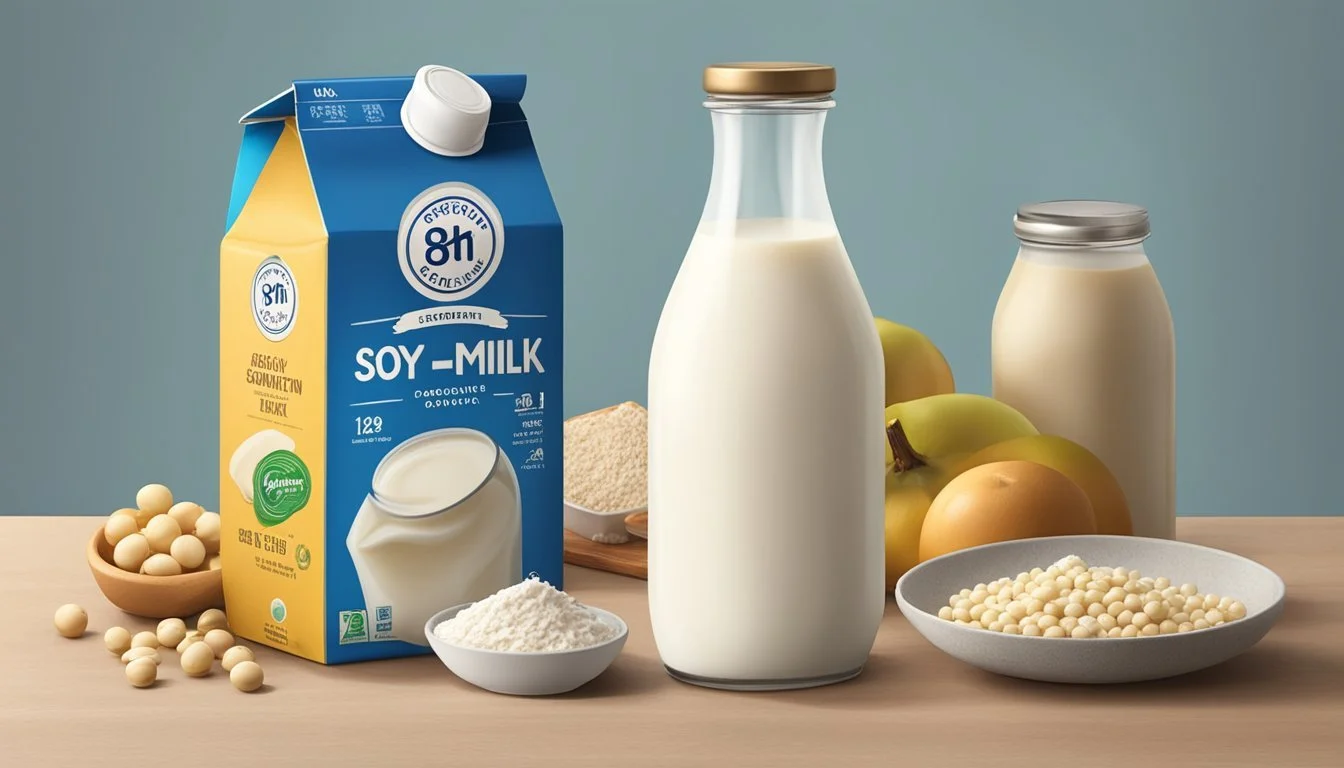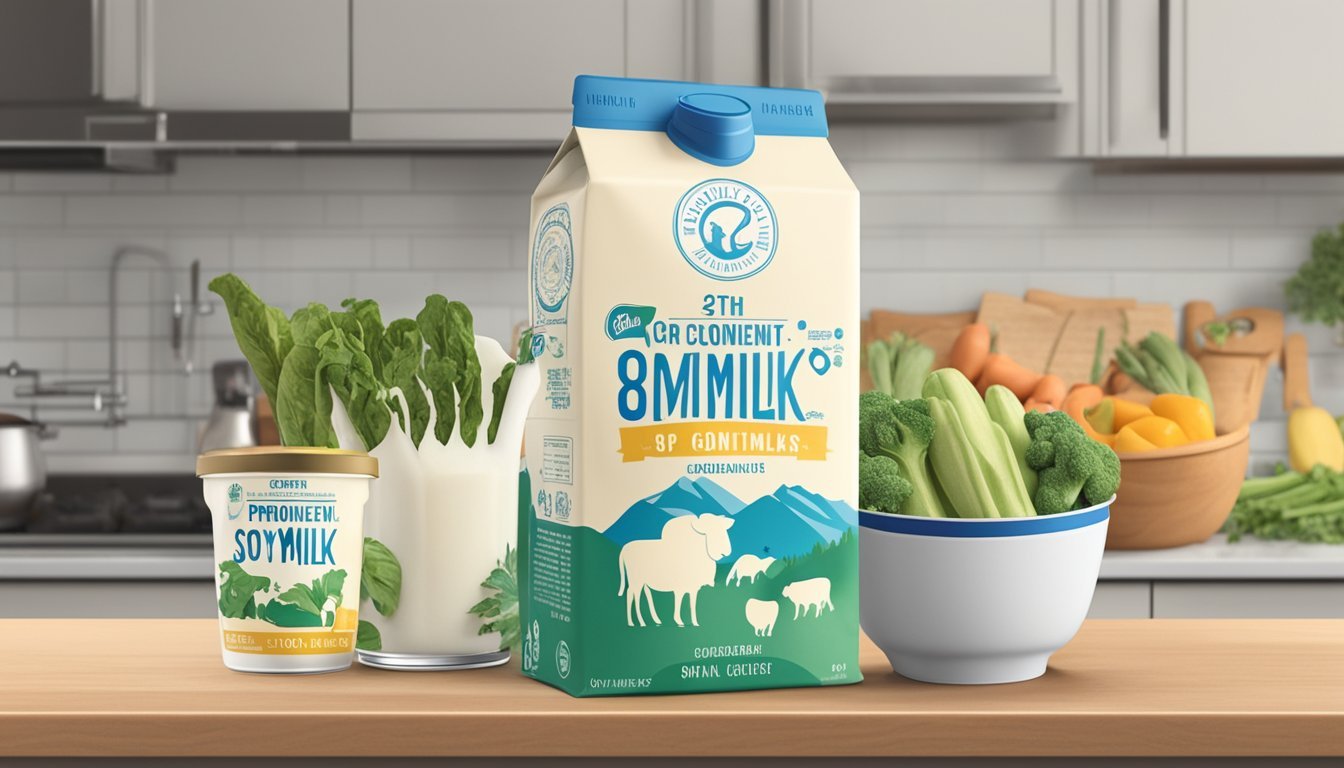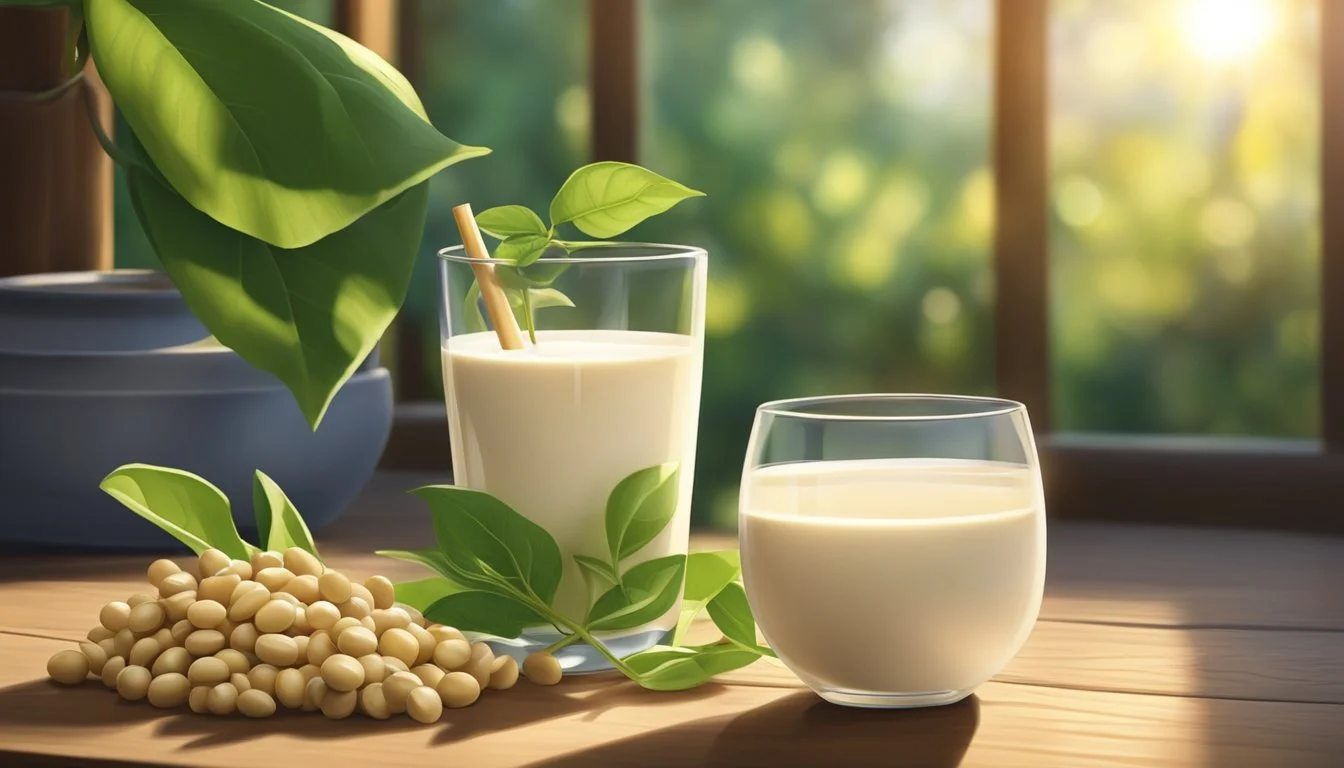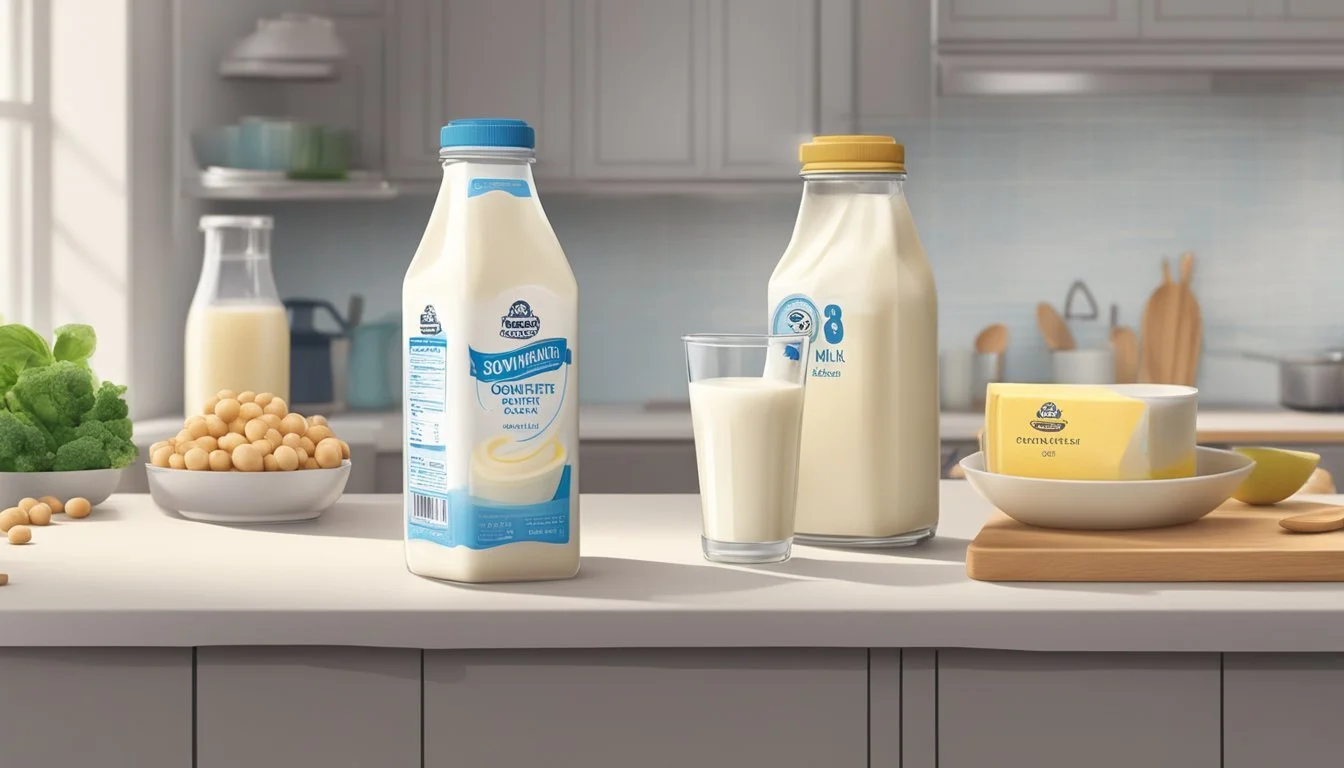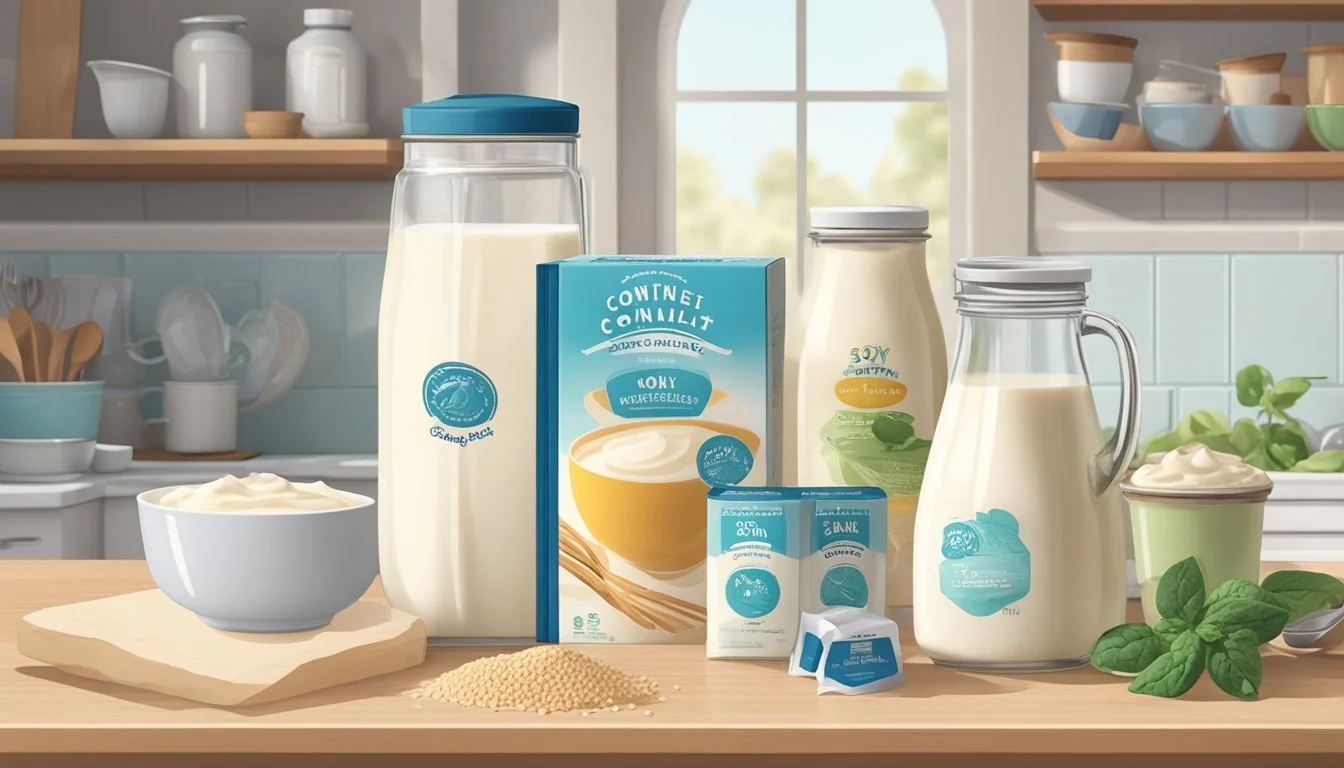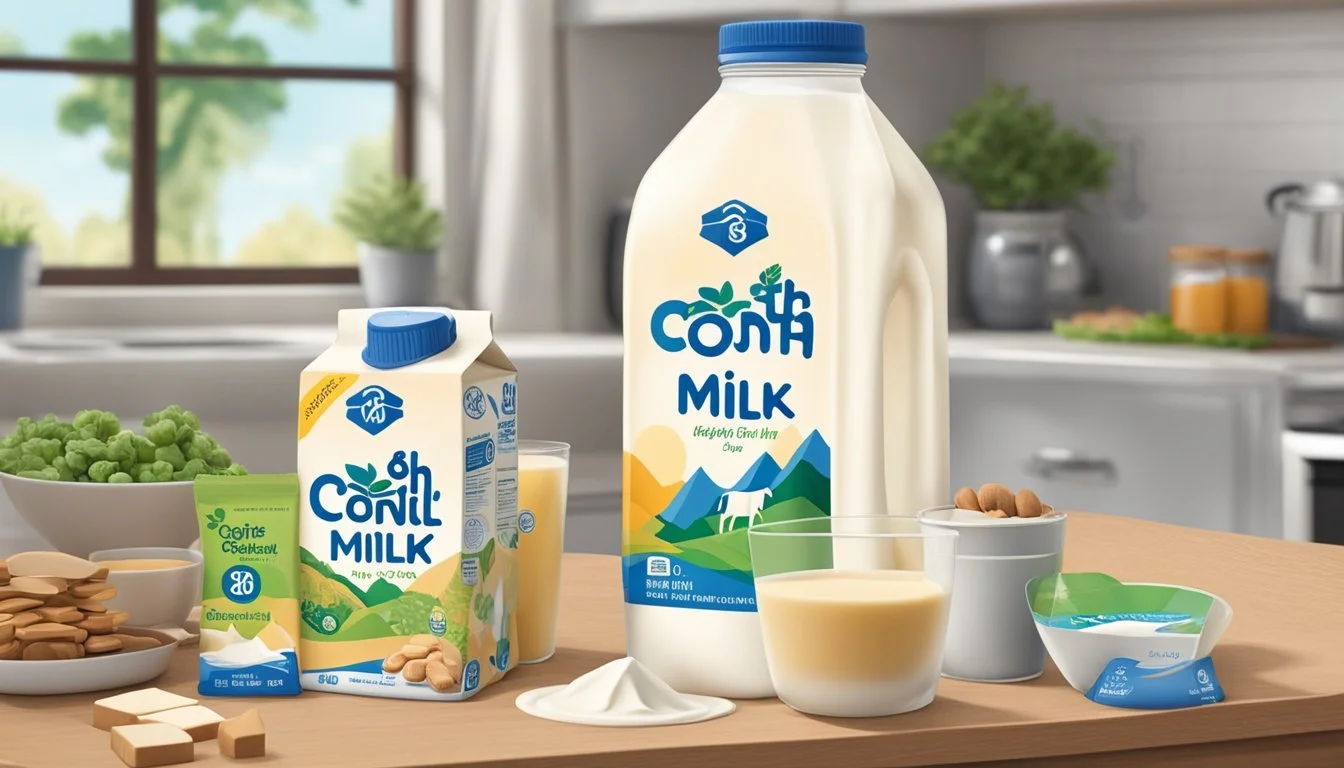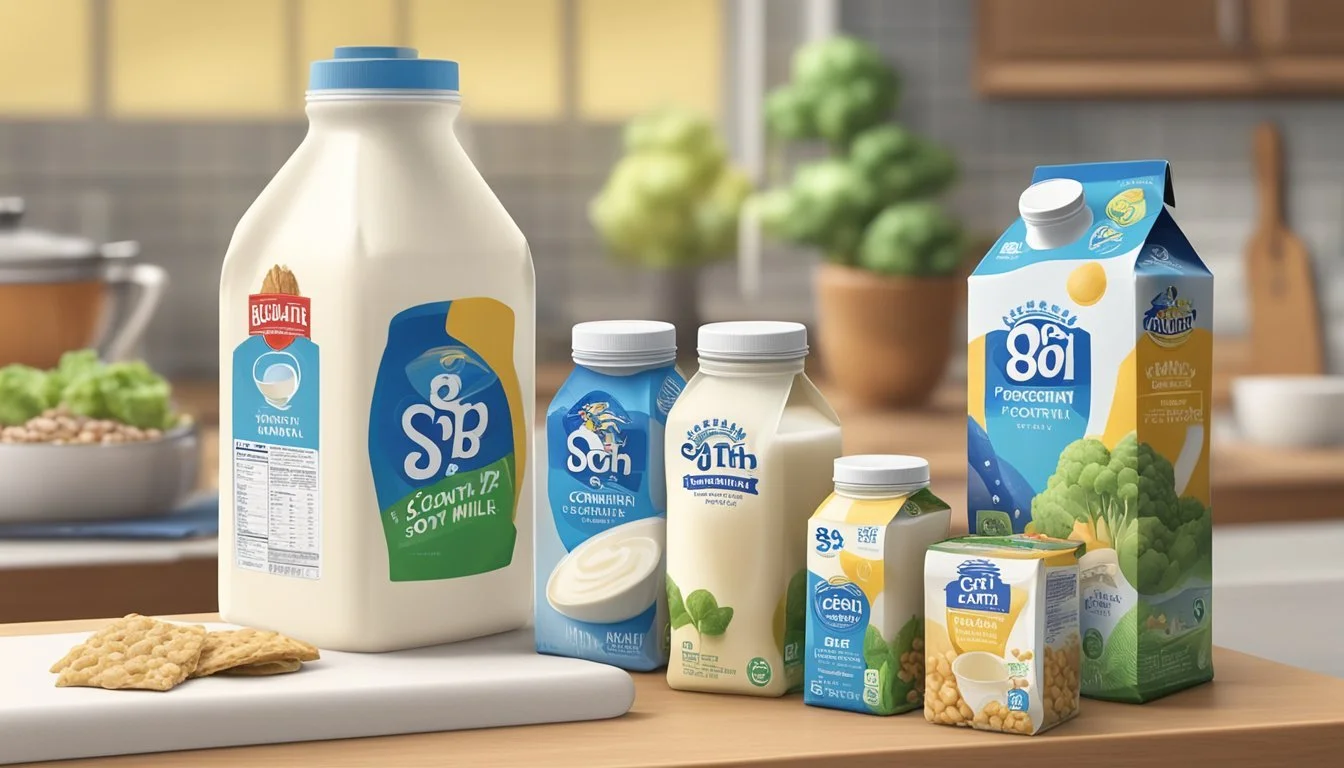How Long Does 8th Continent Soy Milk Last?
Shelf Life and Storage Tips
Soy milk has become a popular dairy alternative, and 8th Continent is a notable brand that offers a range of soy milk products. Understanding the shelf life of soy milk is important for consumers to ensure they are enjoying the product at its best quality and getting the most out of their purchase. Typically, unopened 8th Continent soy milk has a longer shelf life due to the sterilization and packaging processes used to preserve its freshness.
Once opened, 8th Continent soy milk usually follows the same guidelines as other brands of soy milk. It should be consumed within 7 to 10 days for optimal taste and safety. The exact duration can depend on a variety of factors such as the manner in which the milk is stored, the temperature of the refrigerator, and the presence of preservatives in the milk formulation. Consumers should always check the 'best by' date on packaging and look for any signs of spoilage such as a sour smell or changes in texture before consumption.
8th Continent soy milk is a lactose-free, gluten-free, and vegan-friendly product that provides a source of calcium and may contain other added nutrients. The brand promises that their soy milk is made from US grown soybeans, which can be a reassuring detail for those who are conscious about the origin of their food products. As with all perishable products, proper storage is essential. The soy milk should be kept refrigerated and tightly sealed when not in use to maintain its quality.
Understanding Soy Milk
Soy milk is a non-dairy beverage made from soybeans and serves as a popular alternative to dairy milk. Typically, it is created by soaking, grinding, and boiling soybeans with water. The result is a creamy fluid that is naturally high in soy protein, an important source of protein for many people, particularly those who follow a vegetarian or vegan diet.
Nutrient Profile: Soy milk boasts a rich composition of essential nutrients. It is often fortified to provide a nutritional profile similar to that of dairy milk, supplying a significant amount of potassium, calcium, and vitamins, such as Vitamin D and B12. This makes soy milk not only a viable option for those with dairy intolerance but also a healthy choice for people looking to enrich their diet.
Protein Content: Rich in soy protein, a complete protein containing all the essential amino acids.
Vitamins and Minerals: Often fortified with vitamins and minerals such as calcium and Vitamin D.
Health Considerations: Typically low in saturated fats and cholesterol-free, linked to various health benefits.
Certified Options: Available in certified vegan and gluten-free varieties, appealing to a wide range of dietary preferences.
In terms of storage and shelf life, unopened 8th Continent soy milk, like most shelf-stable soy milk brands, can last for several months when stored in a cool, dry place. However, once opened, it is prone to spoilage and should generally be consumed within 7 to 10 days when kept refrigerated. Consumers should observe the milk for any changes in smell, taste, or texture, as these are indicators of spoilage. It is essential to consume the milk before these signs are present to ensure safety and enjoy the beverage's highest quality.
8th Continent Soy Milk Overview
8th Continent Soy Milk is a well-recognized brand in the alternative milk industry, offering a variety of soy milk products crafted to cater to different dietary needs and taste preferences. It stands out as a lactose-free, gluten-free, and certified vegan option for consumers.
Brand History
Stremicks Heritage Foods, a family-owned company, introduced the 8th Continent brand as a subsidiary to focus on soy milk products. It emphasizes the use of US grown soybeans in its soy milk, promoting a domestic source for its primary ingredient. 8th Continent has expanded its product line over the years to include several flavors and formulations, catering to an increasing demand for plant-based milk alternatives.
Ingredients
The primary ingredient in 8th Continent Soy Milk is soy protein, specifically sourced from Solae Soy Protein, which is known for high-quality soy proteins. The ingredient list also commonly includes:
Sugars
Xanthan Gum
Lecithin (Soy)
Potassium Citrate
These ingredients contribute to the soy milk's texture and nutritional profile. Additionally, as stated by the brand, the products are designed to be non-GMO, appealing to consumers looking for genetically unmodified food options.
Types of 8th Continent Soy Milk
8th Continent Soy Milk offers different varieties to cater to diverse preferences and storage requirements, including shelf-stable, refrigerated, and powdered forms, each providing unique benefits.
Shelf-Stable Soy Milk
8th Continent's shelf-stable soy milk is designed for long-term storage, lasting up to 6 months when unopened. It is an ideal choice for consumers seeking convenience and less frequent shopping trips, as it can be stored at room temperature until its seal is broken. This variety's shelf life, once opened, diminishes to less than 12 days and requires refrigeration thereafter.
Refrigerated Soy Milk
The refrigerated soy milk from 8th Continent is kept chilled throughout the distribution process and needs to remain in the refrigerator. The focus on refrigeration ensures that its freshness is preserved. While the exact shelf life is not provided in the search results, consumers should adhere to the expiration date on the packaging and consume the product within a week post-opening for optimal quality.
Powdered Soy Milk
For those who prefer a more extended shelf life or the ability to control portion sizes, 8th Continent offers powdered soy milk. In its unopened state, it can maintain quality for up to 12 months. After opening or transferring it to another container, its freshness is expected to last approximately 3 months. This variation is well-suited for individuals with limited refrigeration space or those who consume soy milk infrequently.
Soy Milk Shelf Life
The shelf life of 8th Continent soy milk, like other soy milk brands, is influenced by storage conditions and whether the product is opened or unopened. Here's what consumers need to know:
Unopened Packages
8th Continent soy milk in unopened packages can generally last for a substantial period when stored properly. These are the key points for unopened packages:
Shelf-stable: Can typically last 6 to 12 months when kept in a cool, dry place away from direct sunlight.
Expiration Date: Always check the expiry date on the package for the best before date as a guideline for maximum freshness.
After Opening
Once opened, 8th Continent soy milk's shelf life diminishes, and the product should be handled differently:
Refrigeration: It is imperative to refrigerate the soy milk immediately after opening.
Consumption Period: Opened soy milk should be consumed within 7 to 10 days for optimal quality.
Signs of Spoilage: Look for changes in color, smell, or taste as indicators that the soy milk should not be consumed.
Health Benefits of Soy Milk
Soy milk has emerged as a popular dairy alternative, offering various health benefits for those who consume it. Integrating soy milk into one's diet can contribute to maintaining a healthy heart. Research indicates that the isoflavones found in soy can help reduce the risk of heart disease. These compounds may have a positive effect on blood vessels, potentially decreasing high blood pressure and reducing the risk of stroke.
When it comes to weight management, soy milk represents a beneficial option. It is typically lower in sugar and contains fiber, which can aid in feeling full and managing hunger, supporting efforts for weight loss or maintenance.
In terms of bone health, fortified soy milk can be a valuable source of calcium and vitamin D, nutrients that play an essential role in the prevention of osteoporosis. Adequate calcium intake is crucial for bone density and strength, and vitamin D enhances the absorption of calcium in the body.
Moreover, soy milk offers a good amount of protein comparable to cow's milk, supporting muscle health and overall well-being. For individuals seeking a lactose-free and vegan-friendly option, soy milk can contribute significantly to a balanced, healthy diet.
Nutrient Benefit Isoflavones May lower risk of heart disease and stroke Fiber Aids in weight management Calcium Essential for bone health Protein Supports muscle maintenance and repair
It's important to note that while soy milk can be beneficial, it may not be suitable for everyone, such as those with soy allergies or specific thyroid conditions. Nevertheless, for many, it remains a nutritious choice aligned with diverse dietary needs and health goals.
Proper Storage Methods
When it comes to preserving the quality of 8th Continent soy milk, adhering to proper storage methods is essential. Storing soy milk correctly prolongs its freshness and ensures that it remains safe for consumption.
Refrigeration is a critical factor after opening. Soy milk should be kept at a constant temperature, ideally below 40°F (4°C). Once opened, it should be returned to the fridge without delay. If it is left at room temperature for extended periods, bacterial growth can occur, leading to spoilage.
In an unopened state, soy milk can be stored in a pantry or any cool, dark place. The pantry should be away from sources of heat and light to maintain the integrity of the soy milk. Here, an unopened container can generally last well past the printed expiration date, provided the temperature remains stable.
If the original packaging is compromised or soy milk needs to be transferred, one should use an airtight container to store the remaining liquid. This container must be clean to prevent any cross-contamination. The lack of air exposure in an airtight container minimizes the risk of bacterial invasion, which in turn helps to maintain the milk's quality.
Before Opening After Opening Store in pantry Refrigerate immediately Cool, dark place Keep below 40°F (4°C) Away from heat & light Use airtight container if original is compromised
It’s vital to note that these methods are aimed at maintaining the milk’s quality as much as possible. One should always inspect the soy milk for signs of spoilage before consumption, regardless of the storage method applied.
Signs of Spoilage
When assessing whether 8th Continent soy milk has gone bad, one should carefully examine its smell, color, texture, and consistency as these characteristics significantly change when spoilage occurs.
Smell
Soy milk that is beginning to spoil typically emits a sour or off odor, reminiscent of traditional dairy milk that has turned. The once mild and slightly sweet scent of fresh soy milk becomes unpleasantly sharp when it spoils.
Color
The color of soy milk can also indicate spoilage. Fresh soy milk usually has a uniform creamy or light beige appearance. If the color shifts towards yellowish or brownish tones or if there are noticeable dark spots, the soy milk could be spoiled.
Texture
A smooth, homogenous liquid characterizes the texture of unspoiled soy milk. Spoiled soy milk may show signs of separation or have floating clumps, indicating a breakdown in its consistency.
Consistency
Soy milk should flow evenly without any visible lumps. If the spoiled soy milk has thickened or has become slimy, this is a clear sign that it should not be consumed.
Impact of Preservatives
Preservatives in soy milk, such as those found in 8th Continent products, play a critical role in prolonging shelf life. By inhibiting bacteria growth and reducing contamination, these additives ensure the milk remains safe and palatable for consumers.
Sodium Benzoate: Often utilized to suppress the growth of microbes, hence prolonging freshness.
Potassium Sorbate: Used to prevent mold and yeast development in food products.
Preservatives function by creating an environment that is hostile to microbial organisms. They disrupt the pH balance, deprive bacteria of needed resources, or interfere with their reproductive cycles. When it comes to 8th Continent soy milk, the inclusion of preservatives is designed to safeguard against premature spoilage, which could happen if bacteria were allowed to proliferate.
It's important to note the dual role preservatives fulfill:
Protection Against Bacteria: They actively prevent the multiplication of harmful microorganisms.
Contamination Shield: Act as a barrier to potential external sources of contamination.
Maintaining the integrity of soy milk involves not just adding preservatives, but also proper packaging and storage conditions to further reduce exposure to contaminants.
8th Continent, and most commercially available soy milks, are subject to stringent safety standards regulated by food safety authorities to ensure that the levels of preservatives are within safe consumption limits. Consumers should still adhere to best-before dates and storage instructions, as preservatives do not render soy milk invincible to spoilage.
Soy Milk in Cooking and Baking
Soy milk serves as a versatile ingredient in various cooking and baking applications. When used in baking, soy milk can easily substitute for cow's milk due to its similar protein content and consistency, producing comparable texture and structural integrity in baked goods like cakes, cookies, and bread.
For those who monitor their nutrition, soy milk offers a plant-based alternative packed with proteins, making it a nutritious choice both in beverages and meals. Moreover, its subtle nutty flavor can enhance the taste profile of various dishes without overpowering them.
In cooking, chefs may incorporate soy milk to create creamy sauces, soups, and custards. Its stability under heat ensures that it does not curdle easily, which is often a concern with other non-dairy milks. Since soy milk has a similar reaction to heat as dairy milk, it maintains a smooth consistency throughout the cooking process.
Below is a guide on how to incorporate soy milk when preparing different foods and beverages:
Baked Goods
Substitute in a 1:1 ratio for dairy milk.
Ideal for muffins, pancakes, and bread.
Beverages
Use as a base for smoothies and coffee drinks.
Can be sweetened or flavored as desired.
Cooking
For creamy textures, add to soups or curries.
Can be used as a base for vegan white sauces and gravies.
It is recommended that cooks and bakers keep in mind the sweetened or flavored varieties of soy milk, which may alter the intended flavor of the recipe. Choosing unflavored soy milk will yield the most neutral taste, making it a preferred ingredient when the goal is to replicate the taste and texture profile of traditional dairy milk-containing recipes.
Freezing Soy Milk
Freezing soy milk can extend its usable life, making it a valuable technique for those looking to preserve this dairy alternative. Freezing should be done with some care to ensure the best possible quality upon thawing.
Steps for Freezing:
Preparation: Shake the carton well since soy milk can separate into layers.
Portioning: Pour soy milk into an ice cube tray or leave enough room in the bottle for expansion—about 1.5 inches from the top.
Storage: Once frozen, transfer the soy milk cubes into a sealable, freezer-safe bag. Label the bag with the date to keep track of how long it has been stored.
Duration: Store the frozen soy milk for up to three months for optimal quality.
Important Considerations:
Texture Changes: Upon thawing, soy milk may experience some texture changes, such as graininess, due to separation. This can be remedied with thorough stirring or by using it in cooking where texture variation is less noticeable.
Thawing: To thaw, transfer the needed amount of soy milk from the freezer to the refrigerator, allowing it to thaw for several hours. Do not thaw at room temperature as it can promote bacteria growth and spoilage.
By following these guidelines, one can effectively freeze and extend the shelf-life of soy milk whilst preserving its nutritional value and taste for future use.
Maximizing Soy Milk Benefits
To tap into the full spectrum of soy milk benefits, individuals should consider how to effectively integrate soy milk into their regular diet and how to pair it with complementary foods.
Incorporating Into Diet
Soy milk serves as an excellent source of protein, especially for those seeking gluten-free options or a plant-based diet. A typical serving provides about 7 to 8 grams of protein. One can start their healthy day by adding soy milk into their breakfast cereal or oatmeal. For a versatile approach, using it as a base in smoothies—alongside vegetables and fruits—or as a dairy substitute in cooking, ensures that one can eat healthy without compromising on taste or nutritional value.
Pairing with Foods
Soy milk pairs well with a variety of foods, enhancing both flavor and nutritional uptake:
Cereal and Oats: A classic combination, soy milk and whole grain cereals or oats offer a fulfilling breakfast with sustained energy.
Fruit: Add soy milk to a fruit bowl or blend into a smoothie for a burst of antioxidants and protein.
Coffee and Tea: Soy milk can be steamed and frothed for use in caffeinated beverages, providing a creamy texture that's both gluten-free and lactose-free.
Savory Dishes: Incorporate soy milk into soups, sauces, and curries to live free of dairy while maintaining a creamy consistency.
By choosing soy milk as part of one's diet, they complement their nutritional intake with a plant-based liquid that supports a health-conscious lifestyle.
Environmental and Ethical Considerations
When examining the environmental and ethical impact of 8th Continent soy milk, one can consider several factors. From production to packaging, soy milk typically uses less water than traditional dairy, affecting both environmental and ethical realms.
Environmental Impact:
Water Use: It is generally acknowledged that soy milk production is less water-intensive compared to dairy milk. This leads to a smaller environmental footprint.
Packaging: Shelf-stable packaging allows for a longer shelf life, which potentially reduces waste.
Ethical Impact:
Health Perspectives: Some consumers opt for soy milk like 8th Continent's for a healthy living lifestyle, seeking non-animal protein sources or dairy alternatives due to lactose intolerance or ethical dietary choices.
Sourcing: Ethical considerations also involve sourcing of soybeans, choosing non-genetically engineered ingredients, or supporting sustainable farming practices.
Table: Key Points of Environmental and Ethical Considerations
Aspect Environmental Impact Ethical Impact Water Usage Soy milk production tends to use less water than dairy milk. Supports sustainable resource consumption. Packaging Longer shelf-life reduces waste. Encourages responsible consumer practices. Health - Aligns with dietary choices focused on health and ethics. Sourcing Can promote sustainable agricultural practices if managed well. Reflects consumer values on non-GMO and organic farming.
In assessing the complete environmental and ethical landscape, one should note that the production and consumption of soy milk, like that of 8th Continent, can present benefits such as reduced water usage and alignment with personal health and ethical standards.
Comparison to Dairy Milk
When discussing the shelf life of 8th Continent soy milk, it's helpful to compare it to traditional dairy milk. Both types of milk are popular choices for consumers, but they differ significantly in storage life and handling.
Soy Milk:
Unopened: Can last from 6 to 12 months when stored properly in a cool, dry place.
Opened: Should be used within 7-10 days and kept refrigerated.
Dairy Milk:
Unopened: Typically lasts from 5 to 7 days past the printed date when refrigerated.
Opened: Advised to be consumed within 5-7 days for optimal quality and safety.
In terms of health considerations, dairy milk naturally contains lactose and animal proteins, which can be problematic for those with lactose intolerance or dairy allergies. On the other hand, soy milk is a non-dairy alternative that provides similar amounts of protein without lactose, making it suitable for people with these conditions.
Soy milk undergoes UHT (Ultra High Temperature) processing, which extends its shelf life significantly more than pasteurized dairy milk. It is important to remember that while both types of milk need to be refrigerated after opening, unopened shelf-stable soy milk offers a longer shelf life due to its different processing and packaging.
Nutritionally, the two also have differences. While dairy milk is rich in calcium and vitamin D, many non-dairy alternatives like soy milk are fortified with these nutrients to ensure consumers still receive their dietary benefits. However, consumers should check the label for fortification as formulations can vary.
Nutrient Soy Milk Dairy Milk Protein High High Lactose None Present Calcium Fortified Natural Vitamin D Often Added Natural
In summary, soy milk offers a non-dairy option with a longer shelf life both in its unopened and opened states, catering to those looking for lactose-free and long-lasting alternatives to dairy milk.
Choosing the Right Soy Milk
When selecting a soy milk like 8th Continent, consumers should consider several factors to ensure they are choosing a product that fits their nutritional needs and personal preferences.
Varieties:
Original: Offers a balanced taste, suitable for a wide range of uses.
Flavored: Includes options like vanilla or chocolate, often containing added sugars.
Nutritional Content: A good quality soy milk is often fortified with essential vitamins and minerals. Look for:
Vitamins A and D: Important for immune function and bone health.
Vitamin B12: Crucial for nerve function and the production of red blood cells.
Protein: Soy milk naturally contains protein, essential for muscle repair and growth.
Special Dietary Needs:
Gluten-Free: Ensure the label indicates that the soy milk is free from gluten if you have gluten sensitivity or celiac disease.
Certified Vegan: For individuals following a strict vegan diet, look for soy milk that is certified vegan.
When shopping for soy milk, consumers are advised to read the nutritional label carefully to verify the product meets their dietary requirements. They should also check for any certifications that are relevant to their lifestyle choices, such as gluten-free or vegan certifications, and consider the type of vitamins that are added to ensure they are aligning with their health and nutritional goals. With a range of options available, individuals can find a soy milk that not only suits their taste but also supports their well-being.
Soy Milk and Special Diets
Soy milk, including brands like 8th Continent, is a versatile option catering to various dietary needs. Typically, soy milk is gluten-free, making it a safe choice for individuals with celiac disease or gluten sensitivity. It's also well-suited for vegans and vegetarians, as it's a plant-based milk alternative.
For those leading an active lifestyle or adults on the go, soy milk offers a good balance of proteins and carbohydrates to support energy levels. It's a practical beverage for post-workout recovery or as a convenient snack during a busy day. The protein content in soy milk can also be beneficial for children in their growth years, as it is essential for their development.
Moreover, soy milk tends to be low in sodium, which is advantageous for people monitoring their salt intake for health reasons. Its lower sodium content helps maintain heart health and supports overall well-being.
To accommodate various health and lifestyle needs, one might look at the nutritional breakdown of 8th Continent Soy Milk as follows:
Protein: Essential for muscle repair and growth, actively supporting an active lifestyle and children's development.
Gluten-Free: Safe for individuals with gluten-related disorders.
Low Sodium: Ideal for heart health and people with certain dietary restrictions regarding sodium intake.
In summary, 8th Continent Soy Milk is a fitting choice for those with specific dietary requirements, whether they're adults or children focused on maintaining a healthy and active lifestyle.
Quality and Production
The production of 8th Continent soy milk adheres to stringent quality process ensuring one of the finest quality soy milk options on the market today. They utilize specialized production methods to maintain high standards throughout manufacturing.
Quality Process
8th Continent soy milk implements a comprehensive quality process, ensuring every carton meets the highest quality standards. They use US-grown soybeans, which are scrutinized for quality from the farm to the manufacturing facility. Each batch undergoes rigorous testing to confirm it meets food safety standards and the brand's specifications for taste and nutritional content.
Production Methods
The company's production methods incorporate both traditional practices and modern technologies to deliver consistent quality. 8th Continent's facilities are designed to maximize efficiency while minimizing the impact on nutritional quality. Their process involves:
Careful selection of soybeans.
Aseptic processing and packaging to enhance shelf life.
Strict temperature controls to preserve freshness and taste.
Through their methods, once opened, the soy milk is recommended to be refrigerated and consumed within 7-12 days for optimal quality.
Soy Milk Myths and Facts
Myth: Soy milk does not contain any protein.
Fact: Soy milk is a good source of protein, providing similar amounts to cow's milk. It typically contains around 7 to 12 grams of protein per 8-ounce serving.
Myth: Once opened, soy milk lasts as long as cow's milk.
Fact: Once opened, soy milk shelf life is shorter than unopened shelf-stable soy milk. Opened soy milk should be refrigerated and used within 7 to 12 days.
Myth: Freezing soy milk ruins it completely.
Fact: Soy milk can be frozen, extending its shelf life for up to three months, although texture changes may affect its desirability for drinking upon thawing. Frozen soy milk is best used for cooking or baking.
Myth: Soy milk can be stored at room temperature indefinitely.
Fact: Shelf-stable soy milk can be stored at room temperature until opened. After opening, it must be refrigerated and consumed within the recommended time frame.
Nutritional Profile of Soy Milk:
Calories: Comparable to cow's milk
Proteins: Essential amino acids present
Carbohydrates: Varies with added sugars or flavoring
Storage Recommendations:
Unopened: Up to 6 months at room temperature
Opened: Refrigerate, consume within 7 to 12 days
Frozen: Use within three months for best quality
It is important for consumers to check expiration dates and storage instructions to ensure the quality and safety of their soy milk.

